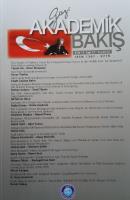Azak Kalesi’nin İşgali ve İstirdadı (1637-1642)
Occupation and Retrieval of Azov Fortress (1637-1642)
Author(s): Ümran Karadeniz, Alpay BizbirlikSubject(s): Politics / Political Sciences, Military history, Political history, 17th Century, The Ottoman Empire
Published by: Gazi Akademik Bakış
Keywords: Azov; Don Cossacks;Black Sea; Ottoman;Russia;
Summary/Abstract: Azov Fortress, which came under the Ottoman rule in 1475, was the farthest point of the north-eastern border of the Ottoman lands. The fortress, which is located in the border area, was mostly used as an outpost, military support unit and supply base since it was not subjected to serious attacks in the first years. The Azov was subjected to sieges in the sixteenth and early seventeenth centuries. However, for the first time in 1637, as a result of the serious siege of the Don Cossacks, it was out of the Ottoman’s control. It is has a special place in Russian history that the Don Cossacks occupied and held Azov fora long time because it was a victory against the Ottoman Empire which was the great power of its era.There are many studies on this subject in Russian literature. While there are very few documents in the Ottoman archive, Evliya Celebi gives the most detailed information among chronicles and travel books.In addition, this period was neglected in the studies and research, and only recently, a study was conducted by Sinan Yüksel in terms of political history. In this respect, it is thought to be useful to discuss the subject in detail due to the existing gap in the literature. In this study, the Don Cossacks’ capture of Azov and the struggles between the Ottoman soldiers and the Don Cossacks during the Don Cossacks’ domination, will be discussed in detail by means of military terms. Besides, the reasons why the Ottoman Empire failed in Azov during this period will be examined.
Journal: Gazi Akademik Bakış
- Issue Year: 14/2020
- Issue No: 27
- Page Range: 221-241
- Page Count: 21
- Language: Turkish

